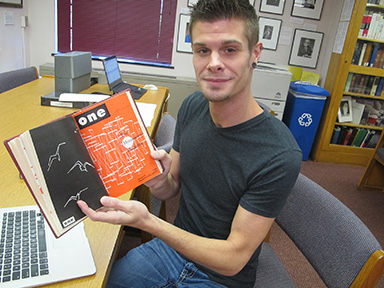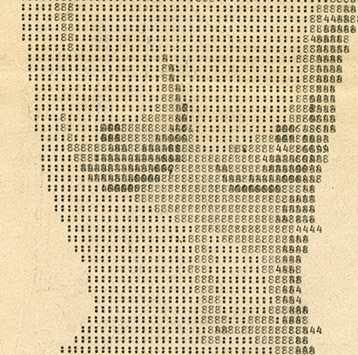Scholars Bring Knowledge to Light through the Kinsey Archives
For academics, summer doesn't mean time off, it's time on for research. The Kinsey library hosts many scholars during the summer months. Here several library visitors - Andrew Clark-Huckstep, Tom Butcher, and Ander Monson - give us a glimpse into their own research, and the treasures at the Kinsey Institute.
Andrew Clark-Huckstep is a Ph.D. candidate in the Department of History at Indiana University.
"The research collections at the Kinsey Institute have been an invaluable resource for the project.“

Tom Butcher is a Ph.D. candidate in the Department of History at the University of Virginia.
"So, my dissertation investigates historical changes in the concept of biological sex (i.e., biological maleness, femaleness, etc.). Specifically, I am arguing that around the turn of the 20th century, a large number of thinkers from a number of different disciplines began to conceive of biological sex as a spectrum rather than a binary. In this spectrum, absolute masculinity or femininity would only exist as a theoretical ideal type, and the majority of people would fall into an intermediary position between the two, with biological elements of both maleness and femaleness in various arrangements. Although many different thinkers in this period (my dissertation runs from 1886 to 1933) conceived of sexual spectra, the particular features of the spectrum, as well as the perceived social and political implications of such an idea, differed greatly from figure to figure."
"At the Kinsey Institute specifically, I was mostly looking into the archived documents of Dr. Magnus Hirschfeld, a Berlin surgeon who was one of the most important figures in the early German gay rights movement. He also suffused his academic writing with a conception of "universal sexual intermediaries," which sought to explain perceived variations in sexual character, as well as homosexuality, cross dressing, and other phenomena, as occupying one of multiple different intermediary sexual positions. He is also widely considered to have performed the world's first sexual reassignment surgery, in 1930 and 1931, which is the subject of the upcoming film The Danish Girl. Above all, in an age when many people are ready to reconsider their conceptions of sex, gender, and sexuality, paying attention to older changes that have occurred in such conceptions can encourage us today to expand our definitions of sex in a way that allows for fluidity while still remaining rooted in biological data."
"Thanks to the Kinsey Institute staff for all the help you gave me, and for keeping these documents preserved for historical research!"


Ander Monson is an author and Associate Professor of English in the MFA program at the University of Arizona.
In July, he visited the Kinsey Institute Library as a Coffee House Press In The Stacks writer-in-residence. Following are excerts from two blogs and an interview he has published about his time in the Kinsey Institute Library.
Sometimes a Dirty Photo Is Also Photographing Love: a Dispatch from the Kinsey Institute Library
"At the least it’s evidence. All libraries are filled with it, but the Kinsey’s something special: secrets and taboo and anonymity amplify the stakes. Sometimes when we make a dirty photo—not always, perhaps not even often—we are also photographing love. It’s this love I leave here with: a naked Peg fused face-to-face to a naked Bob, facing only each other, even if by accident. Of all these instances this is their only truly private joining.
Maybe it’s enough to know they’re here together, and that the Kinsey Library will keep them that way forever."
Computer Art and Sex: Another Dispatch from the Kinsey Institute Library
"I know I’m just showing you some funny bits (also I really can’t seem to stop; listing them brings me such delight), but funny comes from our discomfort with where sex and culture intersect (which is everywhere the more and more deeply you look). Discomfited yet? It’s okay to joke. Step back a bit. Don’t focus on the punctuation marks and suddenly you see a tit."
The Kinsey library is available to anyone at least 18 years old with demonstrable research topic related to human sexuality, gender, and reproduction.
Support Kinsey
Love is more than an emotion. It is essential to our individual and collective well-being. Your support will help the Kinsey Institute advance research and education in the science of love and give a diverse field of researchers the resources they need to make new discoveries.
Pledge your support